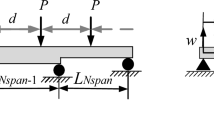Abstract
This study presents the downstream and upstream truss behaviour of a through type newly constructed steel bridge. The modal parameter variation of truss joints of bridge with variable vehicle speed effects have been worked out to determine their flexibility. The testing on the steel bridge was carried out with the same instrument setup on upstream and downstream trusses of bridge subjected to three different speed of the same vehicle. The comparison of the changes in the frequency, mode shape, mode shape curvature and modal strain energy with respect to both the trusses and analytical model has been presented. It has been concluded that upstream and downstream truss of the bridge can behave in different manner even if designed for same loading due to constructional variations and the vehicle movement. The difficulty of modal parameter extraction of the particular bridge under study increased with the increase in speed due to decreased excitation time.













Similar content being viewed by others

References
Parloo E, Guillaume P, Overmeire Van M (2003) Damage assessment using mode shape sensitivities. Mech Syst Signal Process 17(3):499–518. doi:10.1006/mssp.2001.1429
Pirner M, Fry L (2001) Load tests and modal analysis of bridges. Eng Struct 23:102–109
Dutta A, Talukdar S (2004) Damage detection in bridges using accurate modal parameters. Finite Elem Anal Des 40(3):287–304. doi:10.1016/S0168-874X02)00227-5
Gandomi AH, Sahab MG, Rahaei A, Gorji MS (2008) Development in mode shape-based structural fault identification technique. Appl Sci 5(1):29–38
Salawu OS, Williams C (1995) Review of full-scale dynamic testing of bridge structures. Eng Struct 17(2):113–121. doi:10.141-0296/95/010113-49
Wiberg J (2006) Bridge monitoring to allow for reliable dynamic FE modelling. TRITA BKN81 ISRN KTH/BKN/B-81-SE
Kim CY, Jung DS, Kim NS, Kwon SD, Feng MQ (2003) Effect of vehicle weight on natural frequencies of bridges measured from traffic-induced vibration. Earthq Eng Eng Vib 2(1):109–115
Chen SE, Siswobusono P, Delatte N, Stephens BJ (2002) University Transportation Center for Alabama UTCA Report Number 01221
Broquet C, Bailey SF, Fafard M, Bruhwiler E (2004) Dynamic behavior of deck slabs of concrete road bridges. J Bridge Eng 9(2):137–146. doi:10.1061/(ASCE)1084-0702(2004)9:2(137
Alampalli S, Fu G, Dillon EW (1997) Signal versus noise in damage detection by experimental modal analysis. J Struct Eng 123(2):237–245
Shi ZY, Law SS, Zhang LM (2000) Damage localization by directly using incomplete mode shapes. J Eng Mech 126(6):656–660
Yuen KV (2011) Updating large models for mechanical systems using incomplete modal measurement. Mech Syst Signal Process. doi:10.1016/j.ymssp.2011.08.005
SAP2000 (2006) Structural analysis program 10.0.5. Computers and Structures, Inc. Berkeley, CA. http://www.csiberkeley.com
ARTeMIS (2004) Using ARTeMIS Extractor Pro Release 3.43. Structural Vibration Solution A/S Aalborg East, Denmark
Green MF, Cebon D, Cole DJ (1995) Effects of vehicle suspension design on dynamics of highway bridges. J Struct Eng 121(2):272–282
Paultre P, Chaallal O, Proulx J (1992) Bridge dynamics and dynamic amplification factors—a review of analytical and experimental findings. Can J Civil Eng 19:260–278
Canteni R, Walter K (2000) Dynamic interaction between vehicle and infrastructure experiment. Queensland University of Technology Brisbane Australia Report No. 153′031
Wahab MM, Roeck GD (1999) Damage detection in bridges using modal curvatures: application to a real damage scenario. J Sound Vib 226(2):217–235
Shi ZY, Law SS (1998) Structural damage localization from modal strain energy change. J Sound Vib 218(5):825–844
Acknowledgments
The authors would like to thank the Himachal Pradesh Public Works Department, Government of Himachal Pradesh India for allowing National Institute of Technology Hamirpur to conduct the experiment on the steel truss bridge in the state.
Author information
Authors and Affiliations
Corresponding author
Rights and permissions
About this article
Cite this article
Walia, S.K., Vinayak, H.K., Kumar, A. et al. Nodal disparity in opposite trusses of a steel bridge: a case study. J Civil Struct Health Monit 2, 175–185 (2012). https://doi.org/10.1007/s13349-012-0021-4
Received:
Accepted:
Published:
Issue Date:
DOI: https://doi.org/10.1007/s13349-012-0021-4



